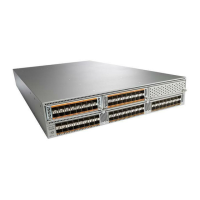•
You can create a SAN port channel with members that are TE-ports, as shown on the right side of the
figure below. In this configuration, the port channel implements a logical EISL (carrying traffic for
multiple VSANs).
Figure 21: Port Channels and VSAN Trunking
•
Port channel interfaces can be channeled between the following port sets:
◦
E ports and TE ports
◦
F ports and NP ports
◦
TF ports and TNP ports
•
Trunking permits traffic on multiple VSANs between switches.
•
Port channels and trunking can be used between TE ports over EISLs.
Understanding Load Balancing
Load-balancing functionality can be provided using the following methods:
• Flow based—All frames between source and destination follow the same links for a given flow. That
is, whichever link is selected for the first exchange of the flow is used for all subsequent exchanges.
• Exchange based—The first frame in an exchange is assigned to a link, and then subsequent frames in
the exchange follow the same link. However, subsequent exchanges can use a different link. This method
provides finer granularity for load balancing while preserving the order of frames for each exchange.
Cisco Nexus 5000 Series NX-OS SAN Switching Configuration Guide, Release 5.2(1)N1(1)
OL-27583-01 97
Configuring SAN Port Channels
Information About SAN Port Channels

